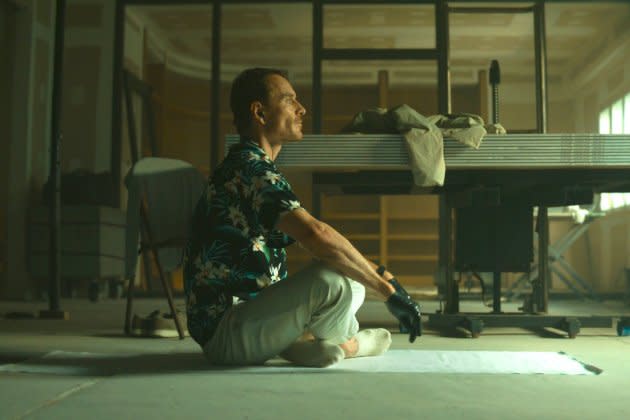David Fincher’s ‘The Killer’ Misses the Mark
- Oops!Something went wrong.Please try again later.
- Oops!Something went wrong.Please try again later.
- Oops!Something went wrong.Please try again later.
- Oops!Something went wrong.Please try again later.

Ten years ago, The Criterion Collection dropped a dual-format edition of Charlie Chaplin’s City Lights. Included amongst its special features is behind-the-scenes footage of Chaplin forcing his co-star, Virginia Cherrill — a socialite the filmmaker spotted at a boxing match — to act out the scene of her blind flower girl handing his Tramp a rose 342 times. Chaplin’s relentless pursuit of perfection earned him the nickname “king of the re-take.” The crown was then passed to Stanley Kubrick who, if Guinness World Records is to be believed, required 148 takes of a scene in The Shining wherein Dick Hallorann (Scatman Crothers) and Danny Torrance (Danny Lloyd) discuss the young boy’s “shining” ability. He also shot 95 takes of Tom Cruise walking through a door on Eyes Wide Shut. Since Kubrick’s passing, the mantle has been assumed by David Fincher.
Fincher, who is now 61, is possessed of a painstaking attention to detail that borders on obsession. The opening sequence of The Social Network was accomplished in 99 takes. Amanda Seyfried estimated that some scenes in Mank were filmed 200 times. When Fincher’s Panic Room star Jodie Foster was asked about his modus operandi, she told The New York Times that he has “obvious O.C.D. problems,” adding, “It would be Take 85, I’d be standing behind him and he’d say, ‘Which one’s better?’ And I’d say: ‘Honestly, you’re a very sick man. There is nothing different between those last three takes.’”
More from Rolling Stone
'Blue Eye Samurai' Is a Gory and Gorgeous Animated Series From Netflix
'Escaping Twin Flames': How to Break Up With an Online Dating Cult
How David Fincher Turned 'The Killer' Into a Mean, Lean Punch to the Gut
Fincher, for his part, explained his meticulousness to the Times thusly: “I hate earnestness in performance. Usually by Take 17 the earnestness is gone.”
You can see why Fincher would be drawn to the unnamed assassin at the center of Matz and Luc Jacamon’s graphic novel The Killer (Le Tueur in its native French). His standards are exacting — punishing, even. He’s become consumed by his strict regimen. When we meet the Killer (played with icy cool by Michael Fassbender) he’s training his rifle on his target’s rooftop hotel suite in Paris from an abandoned WeWork building across the street, waiting for the package to arrive. He is monk-like, laying out a yoga mat to do stretches and waiting till his heart rate falls under a certain level to squeeze the trigger. He puts in headphones and listens to his playlist, consisting entirely of The Smiths. But his mind is racing. Constantly racing. It fills the tedium by waxing philosophical — in Fight Club-esque voiceover — about everything from the mechanical nature of his job and life’s meaninglessness to the rebarbative excesses of late-stage capitalism, e.g. the overwhelming number of McDonald’s in France (1,500, wouldn’t you know?).
“Popeye the Sailor probably said it best: I am what I am,” he offers.
At the risk of getting all Robert McKee on you, the voiceover gets grating fast, and is not as clever or amusing as Fincher and his screenwriter Andrew Kevin Walker (Se7en) thinks it is. A little less conversation, a little more action, please.
While Fassbender doesn’t quite capture the mischievous sense of humor Fincher and Walker sought to instill in him, he does nail The Killer’s cold-hearted austerity, which is near-vampiric. You never doubt for a second that this man has logged his 10,000 hours of contract-killings, and that being in his crosshairs is not a place you want to be.
But you do start to question his methods. Why, for example, is our expert assassin standing right in the window of that abandoned WeWork building for hours, so as to be spotted by an elderly man getting ready for bed in his apartment across the way? Why does he enter through the front door, or get caught on damn near every security camera in his orbit? Is ordering tools off Amazon that will be used to break into a high-security apartment complex really prudent? It would have been more convincing if we were given some early examples of just how accomplished a hitman this guy was before we’re flung right into the Paris debacle. You see, our Killer botches the Paris job, which has dire consequences for him and his loved one, who is beaten to within an inch of her life at their home in the Dominican Republic. Our Killer wants revenge and aims to snuff out anyone who crossed him and his partner. The mission takes him all over, from Europe, to the Caribbean, to New Orleans, to Florida, giving it the sheen of an international espionage thriller.
The Killer is slickly directed and propulsive — this is a Fincher film, after all —amplified by an eerie electronic soundtrack from regular collaborators Trent Reznor and Atticus Ross. Several of its sequences will dazzle you, such as The Killer’s moped escape through the streets of Paris, or a furniture-smashing brawl with “The Brute” that very closely resembles Fassbender’s hotel-room tussle with Gina Carano in Haywire, albeit with considerably worse lighting. For all its globe-trotting wet work, the film’s most riveting scene is The Killer’s confrontation with Tilda Swinton’s white-haired assassin at a tony restaurant over a flight of whiskey. As Swinton delivers a parable, exhibiting a razor-sharp wit and playfulness that’s been missing from the proceedings, you start to imagine what a film about her killer would be like, and whether it would be more intriguing than this one.
The Killer will be released in theaters Oct. 27 and stream on Netflix Nov. 10.
Best of Rolling Stone
